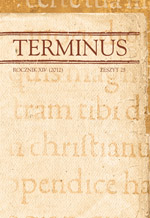Poema de vanitate mundi Jakuba Baldego jako kontynuacja tradycji emblematycznej oraz przejaw siedemnastowiecznego manieryzmu
Poema de vanitate mundi of Jakub Balde. A continuation of emblematic tradition and an example of the 17th century mannierism
Author(s): Maria KozłowskaSubject(s): Language and Literature Studies
Published by: Wydawnictwo Uniwersytetu Jagiellońskiego
Summary/Abstract: The article looks at how the mannerist tradition has influenced a seventeenth century long poem Poema de vanitate mundi by German Jesuit poet Jacob Balde (1604–1668). The paper starts with a general introduction about the author and the poem itself. De vanitate mundi has been described as a part of the mannerist tendencies occurring in different times and places (like the importance of conceit in formulating artistic texts or the role of formal means including extensive enumeratio and experimental cutting out of the syllables), as well as shows these features of it which can be directly connected to emblematic tradition of the early modern period. It focuses on three aspects of this tradition. Firstly – the unconventional role of the image in De vanitate mundi with particular emphasis on its connection to the surrounding printed text; secondly – the variety of paraphrases which form a complex, multi-genre structure of the poem; finally – the influence elogium (a phenomenon directly connected to emblem) must have had on Baldes work. The emblematic tradition has been described as a composite of different tendencies rather than a normative and stable entity. The article aims at tracing this variety of tendencies in Balde poem. Particularly, the Jesuit (or modelled according to Jesuit habits) meditative emblem cycles are presented here as a source of the structure of De vanitate mundi. Also, the article emphasizes how the Jesuit culture influenced the shape and form of De vanitate mundi (e.g. the role of dramatic elements within the paraphrases, the meditative character of the poem or its didactic values).
Journal: TERMINUS
- Issue Year: 14/2012
- Issue No: 25
- Page Range: 219-242
- Page Count: 24
- Language: Polish

